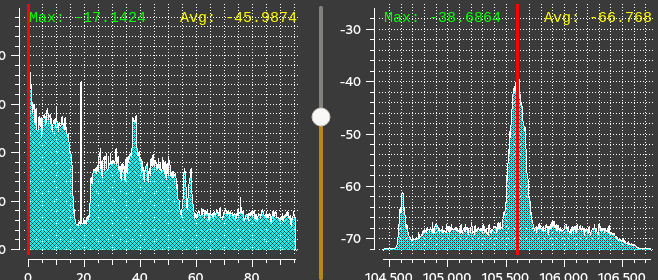
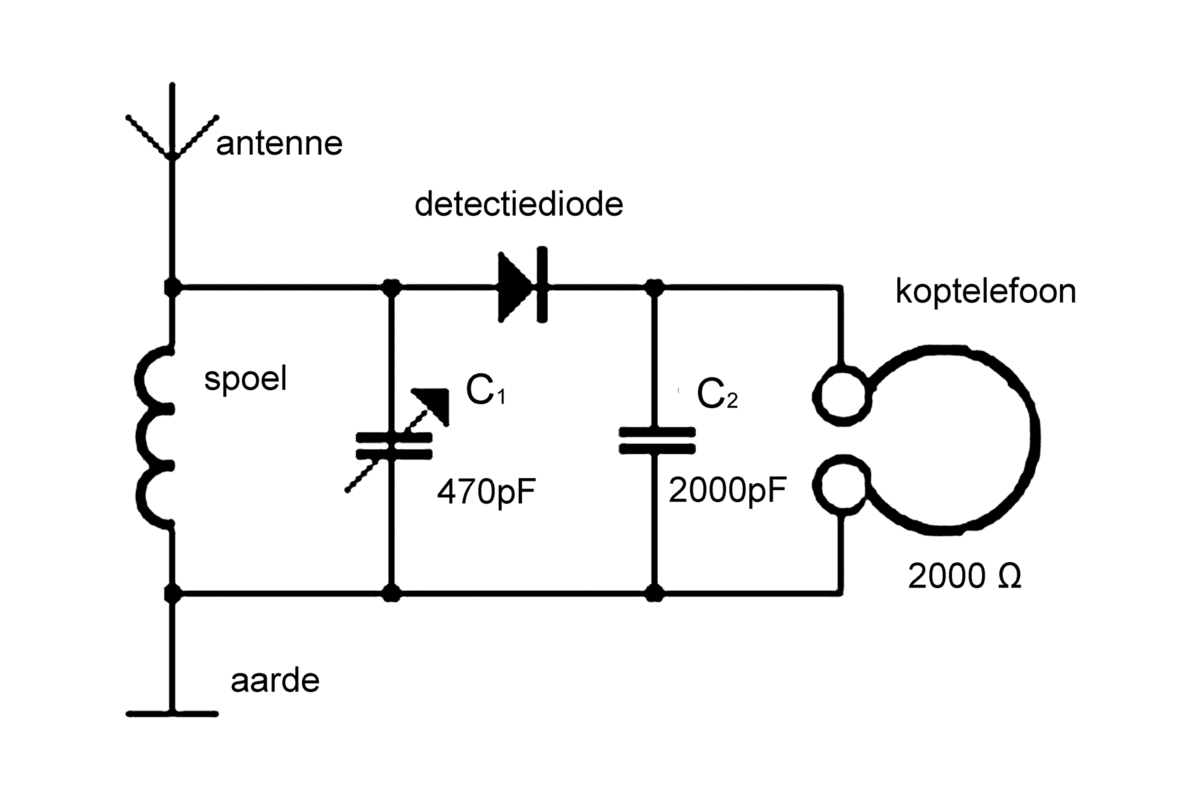
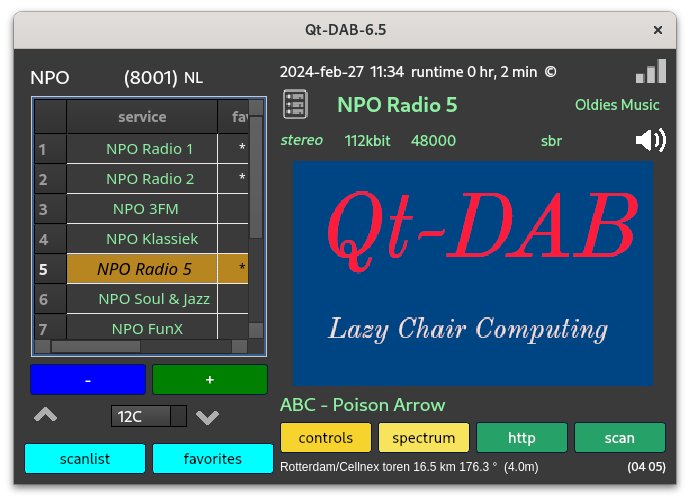
The first radio broadcast in the Netherlands dates from november 1919, i.e. over 100 years ago. The transmission, a live concert in AM, Amplitude Modulation, is said to be a european and even a world scoop.
For a long time AM was the modulation type of choice, from the 20-ties to the 50-ies and 60-ies of the previous century. The type of modulation is
very simple: just vary the amplitudes of the carrier in the rythm of the audio.
The most simple transmitter would be an oscillator with something like
a carbon mike in the antenna lead. Decoding can also be very simple, a coil,
a diode and a head phone would give - with some antenna - sound.
The drawback of AM, primarily transmitted on medium and shortwaves,
is the sensitivity to interferences and noise.
These interferences affect the amplitudes of the received signal, and since the amplitudes (or better the deviations in the amplitudes) are the information carriers, AM is - especially in the built environment - rather noisy. All kinds of electrical equipment,
especially those small power adapters, generate sufficent noise to make
listening to AM transmissions not always a pleasure.
Of course the advantage of using medium and shortwaves is that - depending on conditions - large distances can be bridged.
In the 30-ties there were radio connections between the Netherlands
and Indonesia wwith large shortwwave transmitters.
A second drawback of AM is that the transmission is not very energy efficient,
the signal has a carrier and two sidebands (see picture).
Since the information is stored in both sidebands, and since the carrier
takes 50 percent of the transmitted energy, the efficiency is not more than
25 percent.
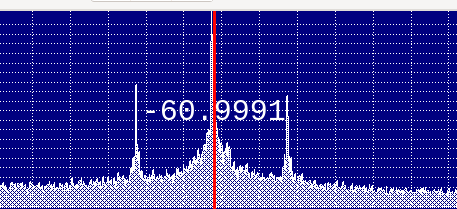
Of course, the main advantage of AM is that equipment needed for receiving AM transmissions can be extremely simple, crystal receivers were the most basic ones. Books and magazines in the 30-ies of the previous century showed schemes and construction descriptions for DIY receivers varying from one tube straight receiver to many tube superheteodyne sets. Even in the 50-ies and early 60-ies, radio magazines (we had Radio Bulletin) gave building descriptions, including layouts for the chassis (I build a number of them).
Amateurs use a variant, e.g. transmission of a single sideband of the
signal, on the 80 meter band the Lower sideband (LSB) is commonly
used, on the bands on higher frequencies the Upper side band (USB) is
commonly used. Decoding USB or LSB signals with a common AM receiver
sounded more like ducks quacking.
There were - already in the 30-ies - several attempts
to transmit stereo signals using AM.
I recall - from long time ago - that - a few times -
the
In the US one approach was to use the side bands to carry the
left resp. right signal. Another approach,
leading to a standard in the US standard is using C_QAM.
In this approach the sum of the Left and right channel signal
was added (i.e. L+R signal) and modulated as "the" regular AM signal,
The L-R signal - required to extract the L and R parts of the signal,
is modulated as a phase modulated signal with
the amplitude cut off to a minimum and then added to the AM signal.
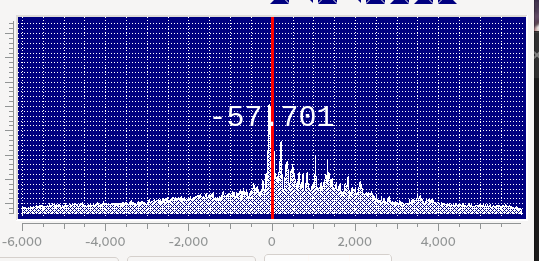
While already invented in the 20-ties of the previous century,
the development of FM really started after the second word war.
With Frequency Modulation, the information is encoded in variations
of the frequency. Amplitudes do not play a role, and FM is therefore less
sensitive to the interferences that effect amplitudes.
FM is positioned in the FM broadcast band, a VHF band from - in Europe
and the US - 88 to 110 MHz.
An important practical difference between AM and FM is the bandwidth
required for FM, which makes sense since the information is encoded in frequency
variations, which may take many Khz.
While an AM transmission in the MW and SW uses a
bandwidth of 9 KHz
(with 4.5 KHz as highest frequency in the payload), current FM
transmissions take a bandwidth of well over 100 KHz.
Of course this comparison is not very fair,
in the FM transmission a stereo signal with an audio
frequency range up to 15 KHz is transmitted, together with additional
RDS information..
The first FM transmissions were all mono, later a stereo facility and
a data facility were added. So a logical question is how to encode a
stereo signal, such that upward compatibility is ensured.
For FM that issue was solved by creating a single signal from the
addition of the Left and Right component of a stereo signal, i.e. L+R
and transmit that as baseband signal and adding an L-R
component on a higher frequancy to get a combined signal.
Mono receivers then decode just the L+R signal and ignore all other
components, stereo receivers extract both the L+R and the L-R signals
and reconstruct the left and right channel data by simply adding and
subtracting the signals.
The L-R signal is AM modulated on a carrier of 38 KHz which is
added to the original signal.
The 38 KHz carrier, used for modulating the
L-R signal is the second harmonic from a 19 KHz pilot signal that -as
the name suggests - is added to the original signal as 19 KHz signal.
Rsing this pilot the correct phases in the 38KHz signal can be restored
and the L-R signal can be extracted as well.
The original Left and Right channel of the stereo signal are then easy to
obtain by some adding and subtracting the signals.
A small data component is also added to the signal, the RDS signal.
Encoded as an 1187 Hz digital signal, this RDS signal is
put on the third harmonic of the pilot, i.e. on 57 KHz.
A picture of the signal is given below. The spectrum on the right gives
the spectrum of the signal as it is being received,
the (half) spectrum on the left shows
the decoded signal. From 0 .. 15 KHz one sees the L+R signal,
the pilot can be seen at 19 KHz,
the L-R signal is clearlt visible, and the small RDS signal at 57 Khz
can be seen as well.

In the (late) 50-ies and 60-ies of the previous century, radio magazines
presented all kinds of DIY receivers. The tuner part, i.e. the part
from antenna to 10.7 MHz IF signal was usually a component one could buy,
the IF stages, the decoding and the amplification home-built.
Since the transmissions were in
the VHF band, an other type of antenna was needed. Propagation of signals
in the FM band is limited, so requirements for antenna and equipment were
more strict than for simpler AM receivers.
(Stereo) FM receivers were
more complex than the AM receivers.
While a traditional AM receiver has a single IF stage - usually
something like 450 or 470 KHz, FM receivers
needed two or more IF amplification stages, with 10.7 MHz as common
IF Frequency. Of course - decoding of an FM signal
is more complex and takes more electronics than a simple diode
(although in software it is trivial again, just take the phase difference
of successive samples, reconstructing the L and the R signal takes more
code).
The introduction of transistors made a real difference,
especially when transmissions became stereo transmissions with additional
RDS data. While the early receivers were essentially "addons" to existing
AM receivers, with a separate tuner, but a limited number of tubes,
later on there was no limit to the number of transistors in FM
receivers.
Second half of the 90-ies of the previous century, attention was given to the use of digital data to encode radio and television signals. In Europe that lead - using Eureka projects - to the development of two standards for digital radio, DAB, Digital Audio Broadcasting, and DRM, Digital Radio Mondiale. The name digital is somewhat of a misnomer, in the end the signals transmitted and received are all analog, the payload is encoded digitally though.
Characteristic for digital transmissions is the spectrum.
Rather than
a single carrier on which the payload is modulated, both DAB and DRM
use many carriers - close to each other, each carrier being modulated
with a small part of the payload. DAB uses 1536 carriers with a spacing of
1 KHz. The bandwidth of the signal is app 1.5 MHz.
DRM, depending on the mode, uses 256 carriers, with a spacing of app 45 Hz.
A DRM transmission - with a width of 10 Khz
fits in the regular short and medium waves broadcast bands.
Processing DRM takesplace with 12000 I/Q samples per second.
DAB is being transmitted
in the "old" Band III, there is room for 4 DAB channels per TV channel,
and there are 39 DAB channels.
DAB decoding is based on a samplerate of 2048000 samples er second,
a DAB transmisison can be seen as a sequences of DAB frames, wehre
each frame takes 196608 amples and is itself built up from 76 data blocks
each with 2552 samples.
A single DAB transmission carries
data for what is called an emsemble, a group of between 10
and 20 services. Here in the Netherlands, we have the NPO
(The National Broadcasters) with app a dozen services, and
the Commercials with app 20 transmissions in a single ensemble.
Where I live I can receive DAB data on about 5 to 6 channels using a single whip as antenna, so in total I have a choice among over 60 services. But, as everywhere, quantity does not imply quality.
DRM, on the other hand, is meant to be transmitted on medium
and shortwaves, in broadcast bands where also regular AM transmissions
are. DRM defines different modes and spectrum requirements that
can be used. Most transmission use a bandwidth of 10 KHz, just fitting into
the bandwidth of AM transmissions.
Decoding DRM takes a samplestream with a rate of 12000 Samples per second
\as input, and - depending on the mode - can be seen as a sequence
of "words", each consisting of just over 300 samples.
Since a DRM transmission carrier digital data, more than a single
service can be encoded in a single transmission. Up to 4 services
can be encoded, although I have never seen a transmission with more than
2 services.
A variant of DRM, DRM++ is meant to be transmitted in the FM broadcast
band and has a bandwidth of 96 KHz, also with 1 to 4 services.
The transmissions I have decoded with my software (well, actually only
recordings of the raw data of these transmissions) carry 4 audio services
(see the picture, left a DRM+ decoder, right a decoder for DRM30).
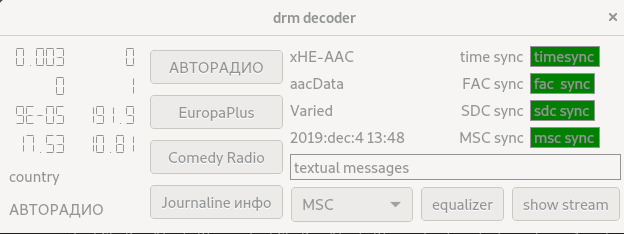
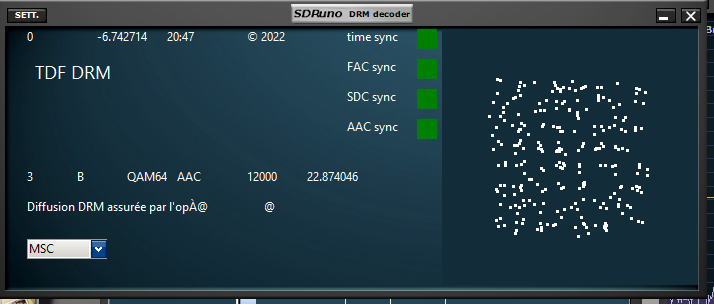
DAB (and its later developed variant DAB+) is the "system of choice"
in Europe, commercials, both in papers, on (FM) radio and TV urge us
to abandon FM and switch over to DAB.
The picture shows the 1.5 MHz wide spectrum (top left) and the waterfall
of the spectrum. Top right (hard to see) is the constellation of the signal,
i.e. a cloud of dots.
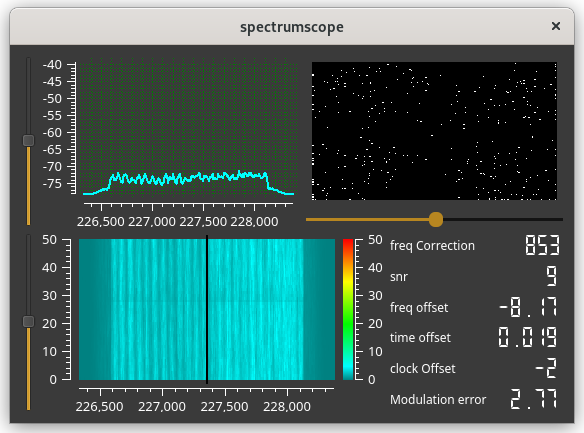
In Europe DRM was not very successful, while in the first decade of this century there were quite some countries with transmissions, I only see a DRM transmission from Kuwait of a couple of hours in the afternoon, and a couple of transmissions from Romenia, in different languages, each transmission for up to an hour. Since some time, I receive a French transmission in the early evening as well. It seems, however, that in other continents DRM is gaining in importance.
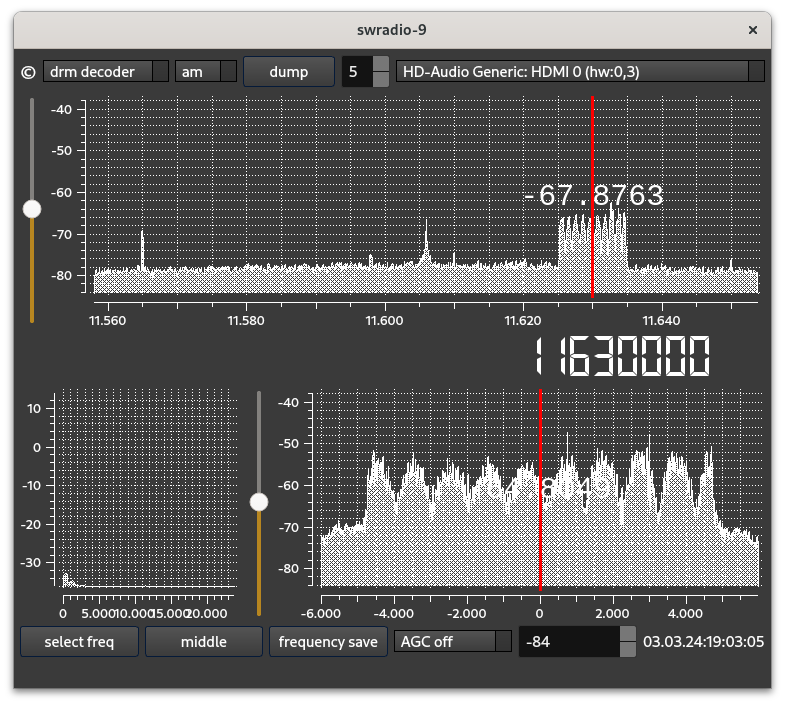
While DAB and DRM were mainly Europe developments, the US took a different,
though interesting, approach.
Their approach was to integrate a digital component with the FM signal,
wuch that the original FM signal still can be received.
The width of the signal is now 400 KHz, fitting in the FM band (of course
due to the density in European FM bands, that approach is not reaslistic here.
The picture shows in schematic form the spectrum of such a signal.
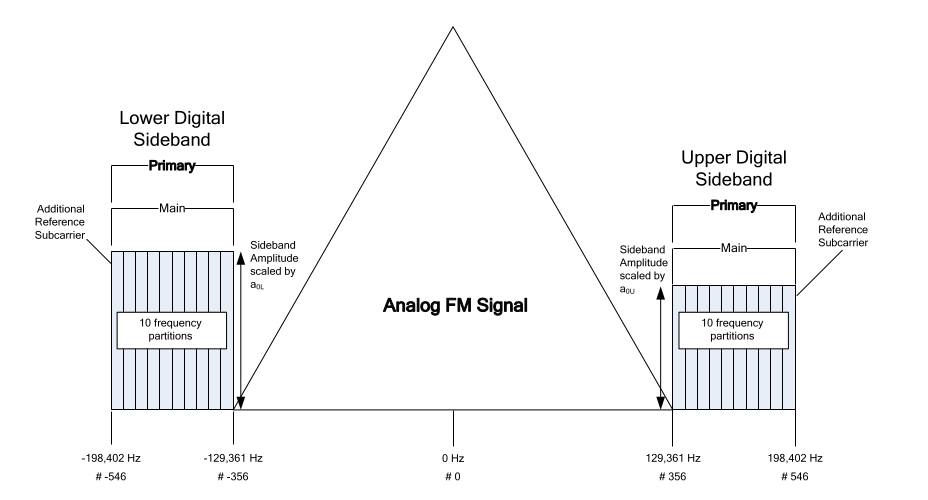
In this in-band/on-channel (IBOC) approach, two sidebands are
added to the signal, where the sidebands are the digital components.
The standard describes different options, differing in the allowed
width of the analog part
and the width of the side bands, up to a complete digital signal.
Encoding the digital part of the signal is - almost obviously - using the
same approach as applied to DAB and DRM, i.e. OFDM.
It is quite obvious that using a simple diode detector, or even a handful transistors, capacitors and resistors, is not enough to build a receiver for the various forms of digital transmissions. Next to something to receive the analog signal and convert it to samples, one does need computing power. Of course, once computing power is available this can be used for AM, single side band, and FM as well.
When applying computing power, e.g. a PC, radio reception requires a separate component for receiving signals, if possible some filtering, transforming the received signal to one on an Intermediate Frequency of 0 Hz, and converting the analog signal into a sequence of samples. Currently there is a tremendous amount of such devices on the market, they all have in common that the covered range of frequencies is up to about 2 GHz or more, and they all can be controlled programmatically using the USB interface. They differin quality, some cheap ones do not have any practical filtering and deliver 8 bit samples, with others transmission is possible as well, and a few good ones have accurate oscillators, pretty good filtering and deliver to up to 14 bits per sample.
Having such a device, decoding AM, single sideband and FM, using a computer is trivial and the most basic form, AM decoding, is essentially only taking the absolute value of a complex sample. In a program this is usually one or at most a few lines of program. Decoding the amateur modes usb and lsb requires some phase shifting, but in software that is no real problem, decoding is - again - expressed in one or two lines of program. The complexity of the software for processing these analog modes is more in filtering and controlling the radio device sending the samples, than in the actual decoding of the signal.
Processing current FM transmissions is slightly more complex, not because of the basic decoding of the signal, which amounts to computing the phase difference of successive samples, but because the raw decoded signal contains an L+R component, a pilot signal, an L-R component and a digital RDS signal. Since for extracting the L-R signal and the RDS signal the pilot is required one needs to implement some DSP algorithms.
Processing digital modes is - again - slightly more complex, usually
an OFDM technique is used. A signal, consisting of the aforementioned
1536 or 256 carriers with the data modulated on it,
is fed into an inverse FFT processor, and after some additions
to ease the decoding of the signal later on, fed through a DA converter
and amplified, shifted in frequency and send to (through) an antenan.
The picture shows the steps in an transmission based on OFDM.
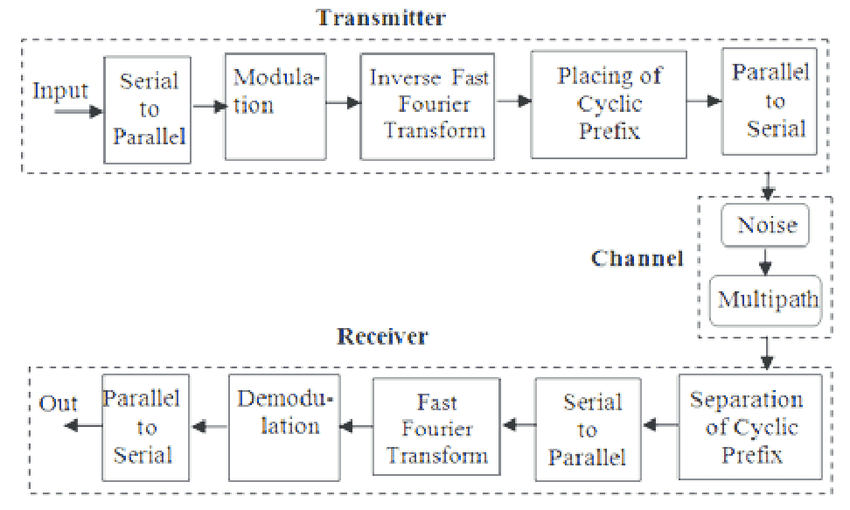
It shows that on the receiver side the process is reversed, the analog signal
is converted into a stream of bits using an AD converter, using an FFT
processor these bits are then converted into someething that
is then eventually transformed into data for audio.
As a rule of thumb, decoding samples from a - digitized - analog AM signal
takes a couples to - at most - a couple of dozens lines of code,
decoding samples from a analog FM stereo signal takes a couple of hundred
lines of code, and decoding samples from an analog DAB signal
takes a few thousand lines of code.
Experience shows that most of the code is in other things, GUI's and controls.
In my DAB software app 70 percent of the code is not (directly) related
to the transformation of the incoming samplestream to the outgoing audio (sample) stream.
As mentioned, in the late 50-ies and 60-ies - my teener years - DIY "radio" was really "in", there were magazines with schemes and building instructions for radios (and of course amplifiers and even TV's) and it was really fun (it actually still is) seeing the glowing of the tubes and hearing the soft hissing and noise when switching on a newly built (variant of the) radio.
After being retired, rather than heating my soldering iron, I started with simple forms of digital signal processing. While starting with data transfer between equipment and computer using a sound card, the fun really started after obtaining (very) decent equipment that is capable of (a) being tuned to a frequency between a few KHz and up to a few GHz, and (b) send IQ samples with higher rates to the computer,
Some of the resulting software is described in this website, DRM and DAB decoding is - I believe - sufficiently interesting, as are the plugins I wrote for SDRuno, the software environment for playing with SDRplay devices.